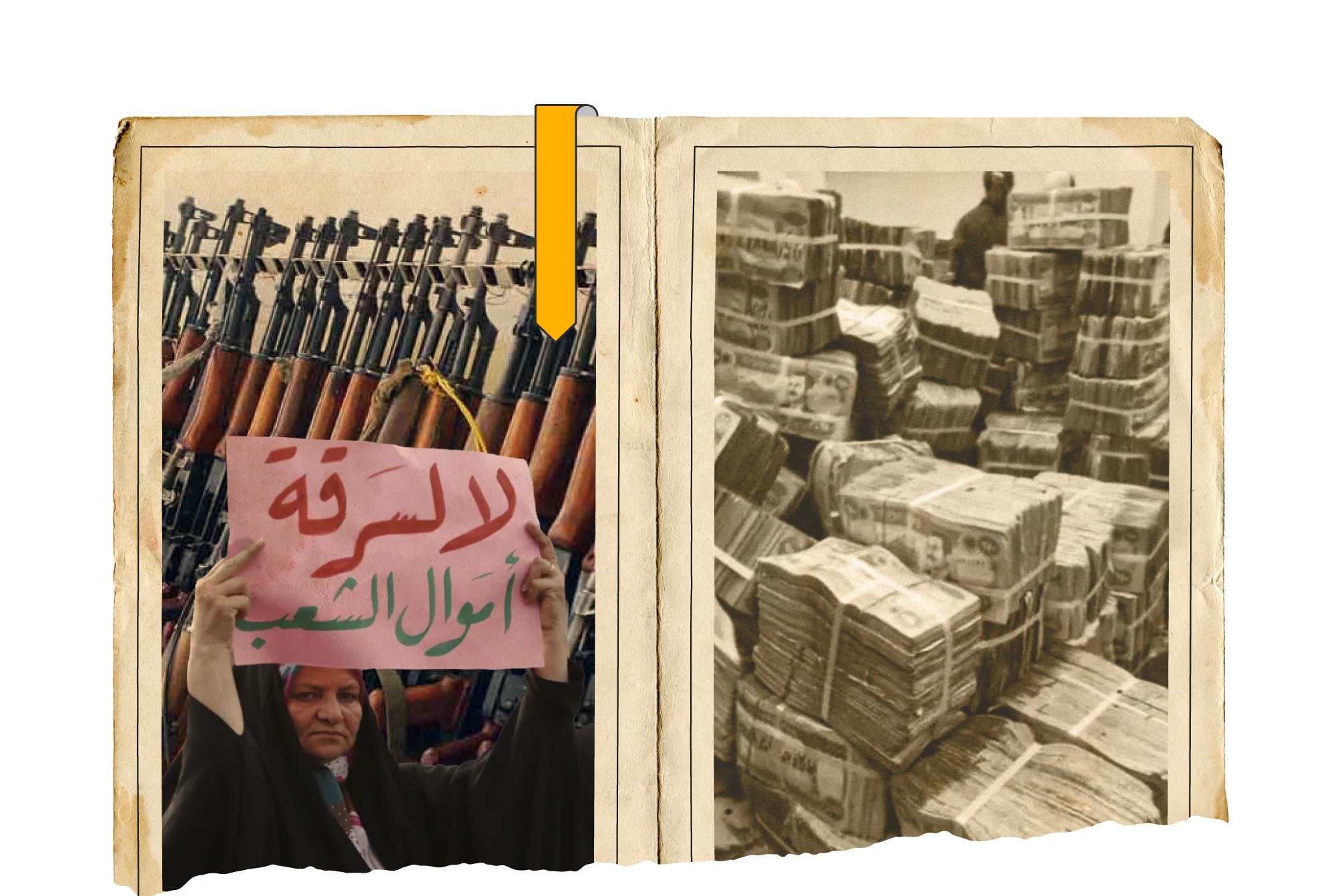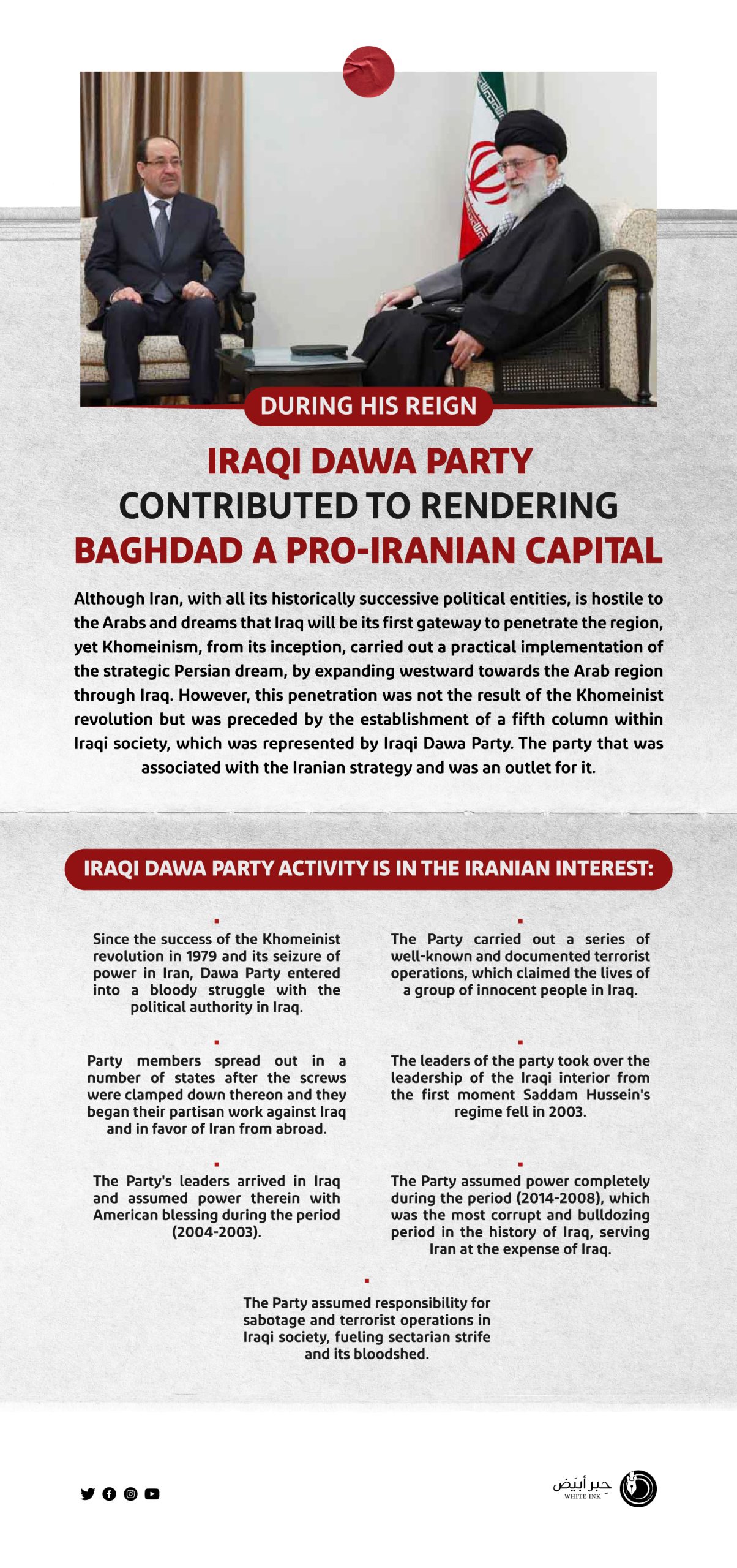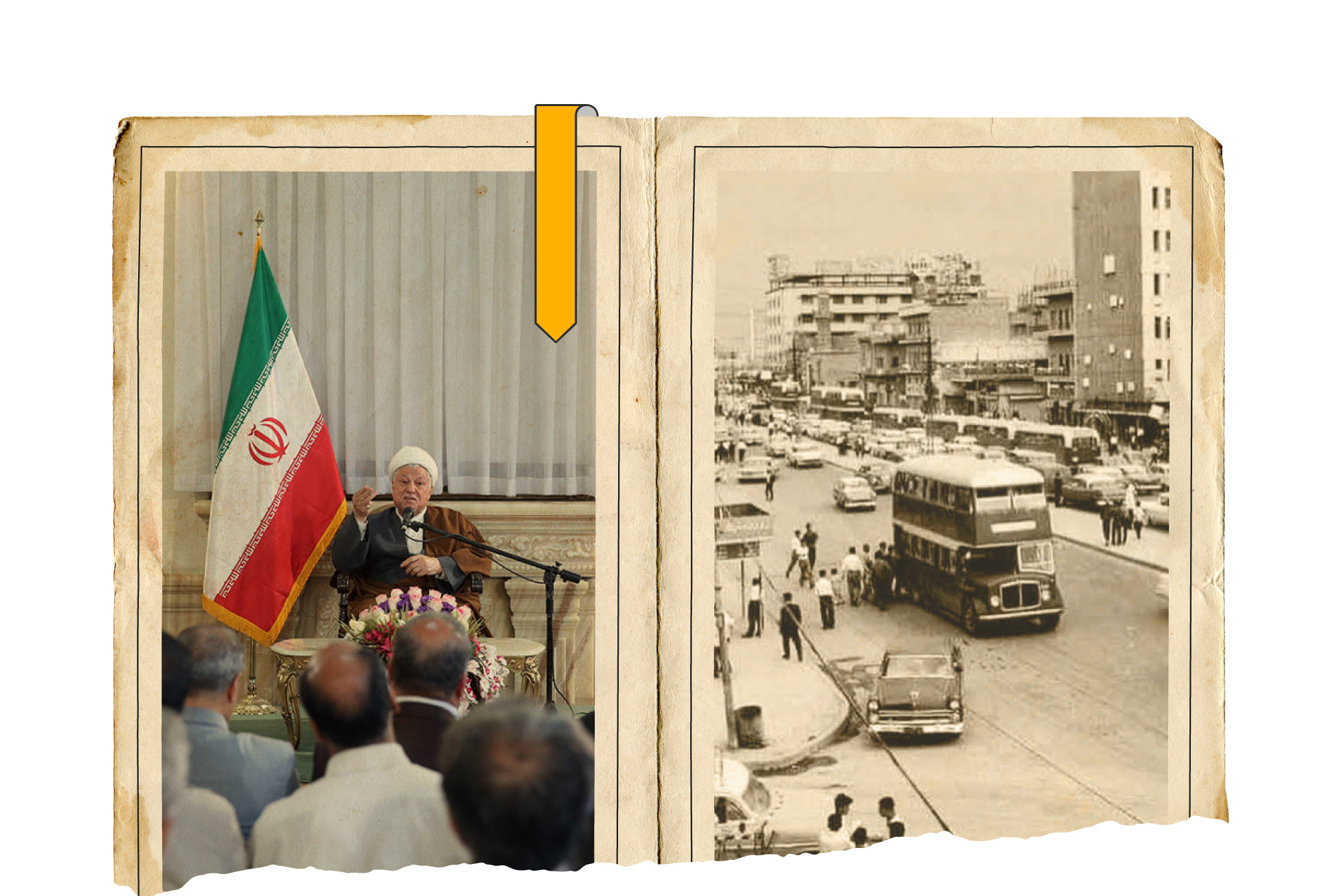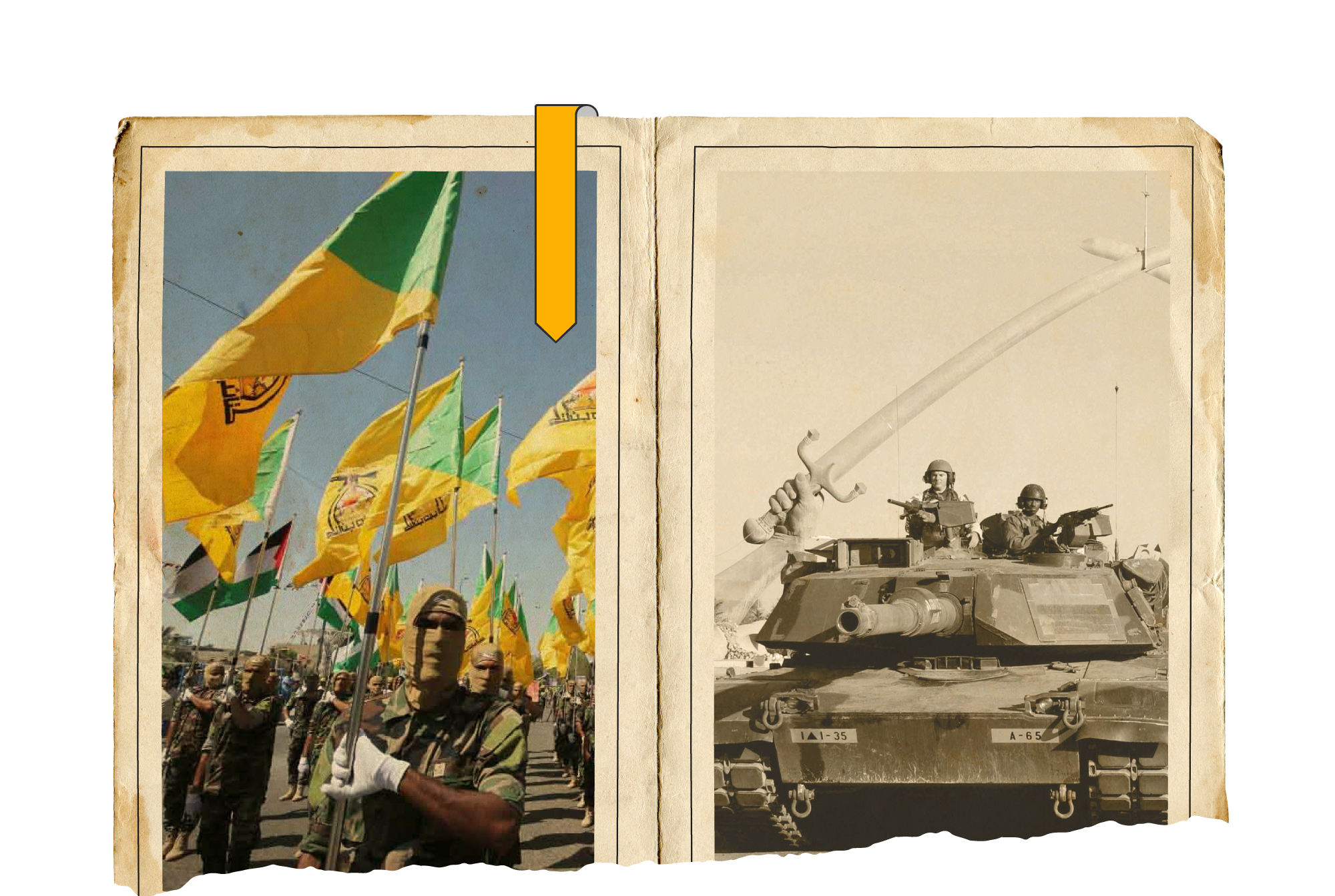
Persian Captivity Attempt to Iraq
Confirmed Intentions to Obliterate Identity, Culture and History
Many years after Khomeinist revolution in (1979), Iranian penetration of Arab Iraq took place through that Persian plant that was established in Iraq, as elsewhere, from militias, parties and supporters, who sold their homelands to its enemies, so that the dreams and aspirations of the occupier were fulfilled. That Arab infiltrator who facilitated the Persian presence and influence may, at first glance, believe that he won a sectarian victory, but he soon discovers that he has lost dignity and independence for sectarian victory. Perhaps most of those who belong to Islamic Dawa Party, which fought a bloody conflict with the former Iraqi regime In (1979), were refreshed for a while by their sectarian victory. However, very soon they discovered that they had sold a homeland with its dignity, pride, fatherhood and history in favor of the enemy. Most of them could no longer help but delve into the service of the Persian party to ensure survival and support.
Iraqi Dawa Party has a bloody record in modern and contemporary history, since it was founded with a sectarian reference loyal to Iran and its implementation of a series of terrorist operations against Iraqi government since (1979); death sentences were issued to a number of party members for high treason to their homeland and to Iraqi people. Many of them fled and moved from Syria to Iran, while some stayed in Syria until the year (2003) and the fall of the Iraqi regime, where some of the party leadership became responsible for internal organizations during their presence in exile, which was inspecting the activities and formations of the party inside Iraq from time to time.
With the passage of time, the sectarian clique residing in Iran became key tools of Khomeinist movement against Iraq and its regime. As soon as the Iraqi regime fell and the American occupier arrived in April (2003), victorious members of Dawa returned from Iran to Iraq. The Transitional Ruling Council was formed and a president was appointed for the Interim National Council, from which the “De-Baathification Commission” emerged, formed by the American ruler of Iraq, Paul Bremer, between the years (2003-2004).
The first elected Iraqi government was formed on 20 May 2006. The Head of the Islamic Dawa Party aspired to run for the position of prime minister of the new government, but he was met with strong opposition from other national blocs. When the representative of Dawa Party ran, his tenure witnessed developments in Iraqi-Iranian relations in the years (2008-2014). The new government sought to build a dual alliance with Iran and the United States, seeking to establish a kind of balance between the American military presence and the Iranian political presence. Iran worked to exploit that in the face of local threats from its political opponents, as it worked to neutralize the Shiite Sadrist movement that opposes its political and religious interference in Iraq. It created a loyal alternative through the Supreme Islamic Council and, in return, Iran supported Maliki government and mobilized enough votes for it from Shiite parties to form a clear parliamentary majority.
In addition, Iran sought to rebuild its historical legacy in Iraq, so it restored the religious school in Karbala, in which Khomeini studied in his youth and also sought to circumvent international sanction, by using Iraq as its economic gateway towards the world. In 2013, the President of the Iranian Trade Development Organization (Karmanshahi) stated that Iraq received 72% of Iran’s total foreign exports and became the largest importer of Iran’s exports. That was demonstrated against and protested by the Iraqis, who considered that as part of the corruption files of Maliki government. Iraqis considered it one of the worst stages Iraq went through in modern history, after documents and Integrity Committee revealed several disgraceful files condemning the sectarian Maliki government.
Among the most prominent corruption files that took a wide dimension is the file of arming Maliki government, was that the Contracts Committee concealed the fate of billions of dollars under the pretext of purchasing weapons, while there are no weapons. It was found that many of these weapons were purchased at prices more than they deserve, and some of them are consumed or used in war Second World War, in addition to the exchange of millions of dollars in bribes between officials of the Ministry of Defense. This was already evident at the time of Iraqi army’s inability to confront the weapons of ISIS during the attack that led to the invasion of Mosul and Salah al-Din in (2015). This included a major corruption file for a fictitious military hospital, for which a billion dollars was dispensed, to provide modern and advanced services to the military. However, it turned out that the hospital does not exist on the soil of Iraq. There is also a file on planes that were purchased from Russia, and it turned out that they are the Iraqi planes that Iran did not give permission to land during the American war against Iraq and had to land in Russia at the time. The Party government returned those planes as new and purchased from Russia.
The most harmful type of corruption to the Iraqi people is the scandals of selling people in the military bases of the Iraqi government at that time, as military officials established detention centers in their military bases, where they used to arrest people and then return them to their families in exchange for large sums of money. This was practiced by the military closest to the head of the puppet government. Among the most prominent types of penetration and corruption in that government was the discovery of 16 private banks that were withdrawing money from the Central Bank of Iraq with fake receipts worth of millions of dollars, which were sent to Iran to help it bypass the international economic sanctions imposed thereon.
Sectarian Iranians sold people, illusion and pain to Iraq.

Regardless of the details of corruption and its countless files of Dawa Party as supported by Khomeinist Iran in Iraq, there remains that political product, the tampering with the legacy and history of Iraq in this way and the attempt to obliterate its identity and show it through a partisan sectarian government that perpetuates corruption and considers it a general situation and culture in a country of civilization, values and principles such as Iraq. Shu’ubi, nationalist and sectarian message was clear by the Persians in Iraq, where Iraq was considered a Persian slave. However, this did not last for long, as Iraq entered a state of recovery from a catastrophe that almost destroyed it.


1. Shaalan Ibrahim, Guardianship of Faqih Theory and Islamic Dawa Party’s Position thereon”, Iraqi University Journal, Issue 44 (2019).
2. Fouad Al-Amidi, “Islamic Dawa Party.. Establishment and Political and Religious Activity between 1957-1974 AD”, Journal of Human Sciences, University of Babylon, Vol. 26, Issue 2 (2019).
3. Al-Watan Bahraini newspaper, “Who will hold Al-Maliki accountable for his crimes, from identity destruction to financial corruption?”, 19 July 2022.
4. Salah Al-Khursan, “Islamic Dawa Party.. Facts and Documents,” Journal of Social Sciences, Kuwait University, Vol. 27, Issue 2 (1999).


Grave shift in the strategic environment of the region
After the West enabled Iran to interfere politically in Iraq's affairs
In the history of Iraq, Ibn Al-Alqami was not just a passing man, as much as he was an idea that did not die but was repeated for a long time. For every calamity that strikes the Arab and Islamic nation, you will find Iran behind, in front of or around it, with dozens of Ibn Al-Alqami lurking in the heart of any conspiracy against the Arab nation. Therefore, with every calamity, search for a conspirator and you will find a lead to Iran.
In all strategies that seek to drain the Arab and Islamic world, or exhaust and blackmail its regimes, or try to subjugate them, you will find Iran the tweezers moved to achieve the West’s projects in the region, especially since the Persian hostility to the Arabs has transcended the pragmatic-reconciliatory dimension to rise to the level of doctrinal and existential hostility to all that is Arab.
In this context, Persian-Western alliance formed a constant path in Iran’s foreign relations since ancient times, especially in the face of Arab Muslims. Historically, according to Al-Tabari, when Khalid bin Al-Walid went to Iraq: ” Muslims gathered and Romans were enraged and sought the help of those who followed it from the armed Persians”.
It can be said that the various stages of Iranian penetration in the region took place with Western blessing, especially since the West did not see in Iran that existential enemy whose danger it feared, despite its continued adoption of a strategy of balance of power in the region in order to avoid the bullying of one party over the other, thus controlling the fate of the region by involving it in regional conflicts that increase its exhaustion and need for Western support.
Manifestations of the Iranian-Western alliance, which resulted in the annexation of some Arab states to Iranian influence, are many and varied. The most recent of these alliances remains what happened on the occasion of the war on Iraq. It can be asserted, regarding the Iraqi case, that Iran would not have dreamt of seizing the capital of the Abbasid state had it not been for the American blessing. The latter used the Iranian bridge and its fifth column in Iraq to overthrow the rule of Saddam Hussein, who did not deal with the neighboring countries as required by neighborhood rights and morals. He fell with great stupidity into the trap set for him by the West, when the poor man believed that America could bless his expansionist projects in Kuwait.
The Persian dream, changing the reality of the Arab region from equality to submission.

The fall of Iraq led to a dangerous shift in the strategy of the region with the collapse of the impenetrable Iraqi wall in the face of Persian projects. Iran succeeded in the process of political expansion and institutional penetration, which led to Iraq becoming a vital field for Iran, and the center of political decision-making moved from Baghdad to Tehran.
Modern colonial mentality shifted from adopting “direct colonialism” to “indirect colonialism”, where controlling the goods of states took precedence over controlling the land. On the other hand, the mullahs are still clinging to the dream of subjugating the land in exchange for giving up a large part of the region’s resources to the West. Here both ends met: the West’s materialistic goal and Iran’s expansionist goal. Thus, the alliance between both parties in Iraq was a prelude to targeting what is much broader and farther from Iraq.
Head of the Expediency Discernment Council of the System, Ali Hashemi Rafsanjani, has previously confirmed this Iranian-American alliance when he confirmed in one of his Friday sermons that alliance in Afghanistan, by saying: “If it weren’t for the Iranian People’s Army that contributed to defeating Taliban, America would have drowned in the quagmire”. It is certain that Iranian support For America is not for free, which is confirmed by facts on the ground and the approved American writings that elevated Iran to the level of the “geopolitical axis” that must be supported in the face of all attempts that may lead to its downfall or implosion from within.
In the same regard, Kingdom of Saudi Arabia has warned since (2002) against the growing influence of Iran in the region and confirmed that it seeks to change the political equation by building an advanced base of support in Iraq, as a prelude to the establishment of a Shiite crescent emanating from its lands, then extending to Iraq, Syria and Lebanon, which is the strategic adoption that will be validated by the events less than a decade from this date. As a result, the Saudi reading was validated and Iraq turned into a vital field for Iran, despite the fierce resistance led by the Arab component in Iraq, in its Sunni and Shiite parts. Perhaps the state of discontent with Iran in Iraq, Syria, Lebanon and Yemen is due to the entrenched conviction among the peoples of these states that “the crises are the direct result of its (Iran’s) unbridled ambitions, which aim to control the region, by sowing the seeds of sectarian divisions and forming powerful armed Shiite factions in the region.


1. Ahmad Haqqi, Nature and Forms of Alliance and Cooperation Through Different Ages between Iran and the West (Amman: Dar Ammar, 2013).
2. Afshan Estwar, “Sectarian Dilemmas in Iranian Foreign Policy: When Identity Politics Collide with Strategy”, a study published on Malcolm Kerr-Carnegie website on 30 November 2016.
3. Sayed Mousavi, “Iran and the West… a confrontation between policies”, Center for Strategic Studies, p. 122 (2006).
4. Muhammad Al-Obaidi, “Iranian Political System and the Challenges of Relationship with the West 1979-2008”, Journal of Regional Studies, University of Mosul, Vol. 6, Issue 17 (2010).

By fighting to disable Baghdad to catch up with civilizational march
Iran Worked on Systematic Bulldozing in Iraq
New Persian strategy was based on replacing loyalty to the sect at the expense of loyalty to homelands, promoting among peoples and minorities that the idea of sect is the basis, rather than nationalism and patriotism that they follow. Hence was the call came to Wilayat al-Faqih as a haven in which Iranians could meet with other minorities, peoples and nationalities. Later, their loyalty to Iran was used indirectly, portraying Iran as the only haven for the sect in the world.
Khomeini and the mullahs considered that Iraq is the jewel of the Iranian sectarian crown that they dream of establishing one day. Sectarianism that they spread was only a bridge to cross towards building the Persian nation-state, no matter how hidden they were behind stories, myths and superstitions. Therefore, the focus was on Iraq more than others; being a geographical extension of Arab Ahvaz region, as remaining independent necessarily means disruption of the Iranian occupation of Ahwaz, in addition to its being an eastern gateway to the Arab world and controlling it means controlling an important part of the world’s oil, water and agricultural wealth. Further, Iraq is an advanced base for controlling the rest of the Arab region all the way to the Arabian Peninsula and the holy places therein, so as to turn them into shrines and to introduce Zoroastrian ideas and beliefs into them, as the Safavids did one day.
The Iranians used the policy of attacking from abroad and adopted military effort, contradicting their doctrine that they built over hundreds of years by outsourcing to carry out wars on their behalf (recruiting Hezbollah and Houthis, for example). This was because they knew that they were unable to penetrate the solid Iraqi body from within, which was built on a patriotic, nationalist belief. They deliberately exhausted it from the outside in a long war that lasted more than eight years during Iran-Iraq war, while preparing mercenaries, saboteurs and agents to push into the Iraqi interior at any political or security weak moment.
Iran was never able to carry out any activity inside Iraq after Iranian revolution, especially in the 1980s and 1990s. Hence, Tehran modified its plan and built sectarian and armed networks, organizations and currents that it trained for years inside Iran. So, it was not a soft penetration as it did in Yemen or Lebanon at the beginning, but rather an organized armed action that lurked over twenty years, until the year (2003). Following the American occupation of Iraq, sectarian and militia poison was injected into the body of Iraq to exhaust and eliminate it.
Iranian Political Penetration into Arab Neighboring Countries, authored by Wasfi Aqil and Khaled al-Dabbas, describes Iranian practices to penetrate its Arab neighborhood as a strategy that relied on subjugating elite society, i.e., partisan political classes, as well as societies, by cultivating sectarianism and loyalty to the sect at the expense of homelands.
The Persians exhausted Iraq by spewing sectarian and militia poison.

Iran deliberately did not recognize Iraq as an independent state. Here, we are not talking about the current Iranian state that is controlled by the mullahs, but rather about the Shah’s Iran. Iranian ambitions in Iraq, its lands and its long history are basically Persian ambitions, sometimes covered by the Persian nationalism that the Shah represented and, at other times, by Safavid sect, which is currently represented by the mullahs.
It is also indicated in Iranian Political Penetration into Arab Neighboring Countries that: “Iran did not historically recognize the independence of Iraq and official relations remained tense, ignoring recognition of political borders until 1975, when both states signed the Algiers Agreement to demarcate borders. Then that agreement collapsed after the war broke out between them in 1980. Following the fall of Saddam Hussein’s regime in 2003, Iranian-Iraqi relations improved under the new government, which was dominated by pro-Iranian representation”.
Fall of Baghdad… Fall of Iraq:
The fall of Baghdad as a result of the American occupation (2003) was not just an occupation of an Arab capital. Rather, it was a resounding downfall of the civilization of the Umayyad and Abbasid Caliphates, and the Arab civilization, which was manifested in its brightest form in Baghdad Al-Rashid and other caliphs.
Baghdad was not just a passing city in the Arab conscience, but the icon of capitals, the most present in history, jurisprudence and human sciences. Hence was the tyrannical Persian hatred for Baghdad, stone and people, represented in the tens of thousands of terrorist bombings and killings on identity and intimidation practiced by militias affiliated with Iran after the fall of Baghdad. The number of murdered and displaced persons was estimated at more than two million, not to mention economic, educational, health and developmental collapse. Iraq has fallen back on the ladder of civilization because of the Iranian occupation thereof for hundreds of years. Researcher Muammar Faisal Khouli says in his publication: “The overthrow of Saddam Hussein’s regime in 2003 came as a historic opportunity for the Iranian regime to transform its relationship with Iraq, which was previously one of its fiercest enemies, taking advantage of the long and porous borders with Iraq and its long-term relations with major Iraqi politicians, Iraqi parties and armed groups, as well as its soft power, represented in economic, religious and media fields in order to expand its influence and consolidate its position therein”.
Occupation of Iraq by the United States of America is considered the largest strategic gift given to the Iranian regime to proceed with its expansionist project. Thus, it began with tightening control over Iraq, to later expand in the Arab East states. That project had its motives, forms and influential tools. There are several motives that led Iran to enter as one of the main parties in the developments in the Iraqi arena, the most prominent of which are: transforming Iraq into a strategic launching platform for the region; given the Iranian strategic interest that sees Iraq as an important starting point for Iranian incursion into the rest of the states of the region, towards Syria, Lebanon, Jordan and the Arab Gulf states.
Security challenge to Iraqi government has escalated. In light of the Iraqi government’s inability to confront “ISIS” organization, which was created and supported by Tehran itself, Iran exploited Iraq’s needs and the conditions it is going through.
By the nature of the US policy towards Iraq, Barack Obama administration encouraged the Iranian role to influence Iraqi internal balances. Although Iran did not officially participate in the international coalition to fight terrorism led by Washington, the US administration welcomed the Iranian role in Iraq, which means giving Tehran the green light to play its role in Iraq.
Penetrating power is the way to the heart of Iraq:
Iran has benefited greatly from the American occupation of Iraq and its building of a political system based on parties stemming from a sectarian dimension and external loyalty. Iran was fully prepared and was able, through the institutions that the American occupation built, in parliament, provinces and ministries, to infiltrate it through elites that owe allegiance to Tehran. Rather, it has turned into a system of employees who obey Iranian directives and work for the benefit of stated other than their own.
Penetration was deep and cruel as Tehran began to get rid of every person it believed was a threat to its occupation project. Killing and assassination of the educated and independent Iraqi elites was a phenomenon that spread throughout Iraq, claiming the lives of tens of thousands of soldiers, politicians, doctors, engineers, scientists, university professors, poets, writers and intellectuals. It was a systematic razing of Iraq. Iran’s agents in Iraq also implemented a policy of confronting any Arab-Iraqi relations or reconciliation, with the aim of isolating Iraq from its Arab surroundings and space.
In conclusion, Iran is seeking, through the destruction of Iraq, to achieve two objectives: First: Savage vengeance of the feeling accumulated within the Iranian conscience against everything that is Arab, and Iraqi in particular. Iraq, which was once occupied by the Sasanian Empire, was transformed during the era of the Umayyads and Abbasids to be the capital of managing Persian affairs, from which armies and administration of Khorasan and the rest of the Persian provinces depart. Therefore, Iraq shall remain very sensitive to Iran.
Second: The ruling elite in Tehran cannot accept that the state it controls is better than its own, especially since it has completely failed to improve, develop or advance the conditions therein. Today, Iran is considered one of the most backward and deteriorating stated at all levels. Is it logical that Tehran would accept that Baghdad becomes an advanced, enlightened and luminous capital?!, which fully applies to Beirut or Sana’a as well.


1. Ahmed Hakki, Nature and Forms of Alliance and Cooperation Through Different Ages between Iran and the West (Amman: Dar Ammar, 2013).
2. Afshan Estwar, “Sectarian Dilemmas in Iranian Foreign Policy: When Identity Politics Collide with Strategy”, a study published on Malcolm Kerr-Carnegie website on 30 November 2016.
3. Muammar Khouli, “Iranian infiltration into Iraq… motives, forms, and tools of influence”, Rawabet Center for Research and Strategic Studies, Encyclopedia on Iraq (2016).
4. Wasfi Aqeel and Khaled Al-Dabbas, “The Iranian Political Penetration of Arab Neighboring Countries… A Case Study of “Iraq, Bahrain, Yemen”, Journal of Humanities and Social Sciences Studies, University of Jordan, Vol. 45, Issue (4) (2018).





